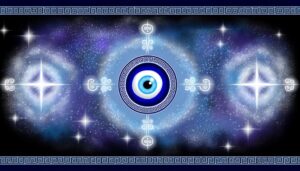Veil Over Eyes Spiritual Meaning: Hidden Truths Revealed
The spiritual concept of a ‘veil over the eyes‘ represents the obstruction of divine understanding and enlightenment, prevalent in various religious traditions. In Christianity, it signifies humanity’s separation from God (2 Corinthians 3:14-16).
Hinduism views ‘Maya’ as an illusory veil that conceals ultimate truth. Islam associates veiling with spiritual modesty, while Buddhism equates it with ignorance obstructing enlightenment.
This motif underscores the universal human endeavor to transcend superficial perception and attain profound spiritual insight. Understanding this symbolism opens pathways to exploring deeper esoteric and mystical truths, revealing more about the journey toward spiritual awakening and divine wisdom.
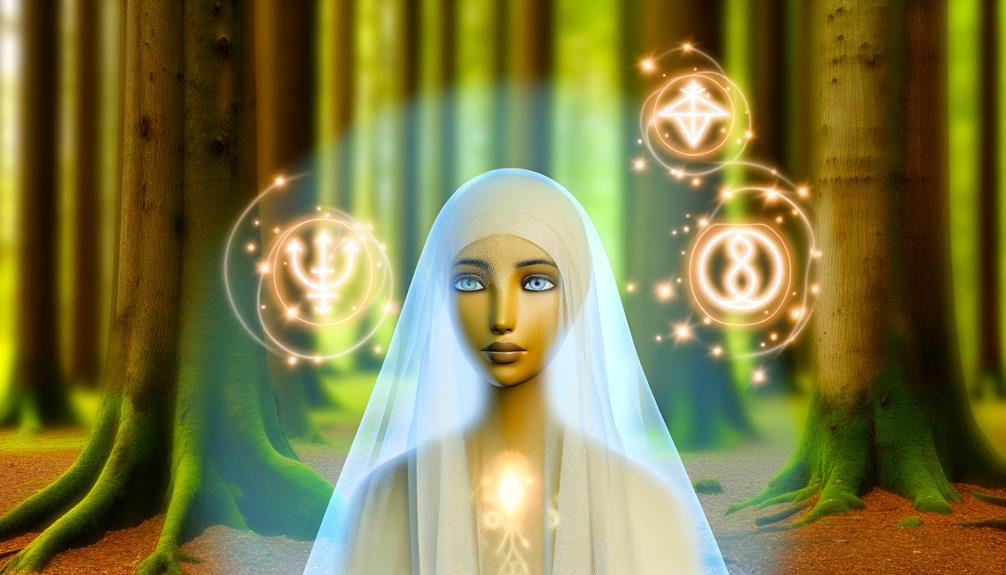
Veil Over Eyes Spiritual Meaning: Hidden Truths, Awakening, and Inner Revelation
| Aspect | Spiritual Meaning |
|---|---|
| Hidden Truths | Symbolizes unseen realities or concealed knowledge |
| Spiritual Awakening | Indicates the beginning of deeper awareness and inner seeing |
| Intuitive Clarity | Represents the lifting of illusions and clearer perception |
| Transition Phase | Marks a shift from ignorance to understanding |
| Emotional or Mental Fog | Suggests confusion that precedes personal or spiritual insight |
| Divine Revelation | Associated with moments of sudden clarity and spiritual truth |
Historical Origins
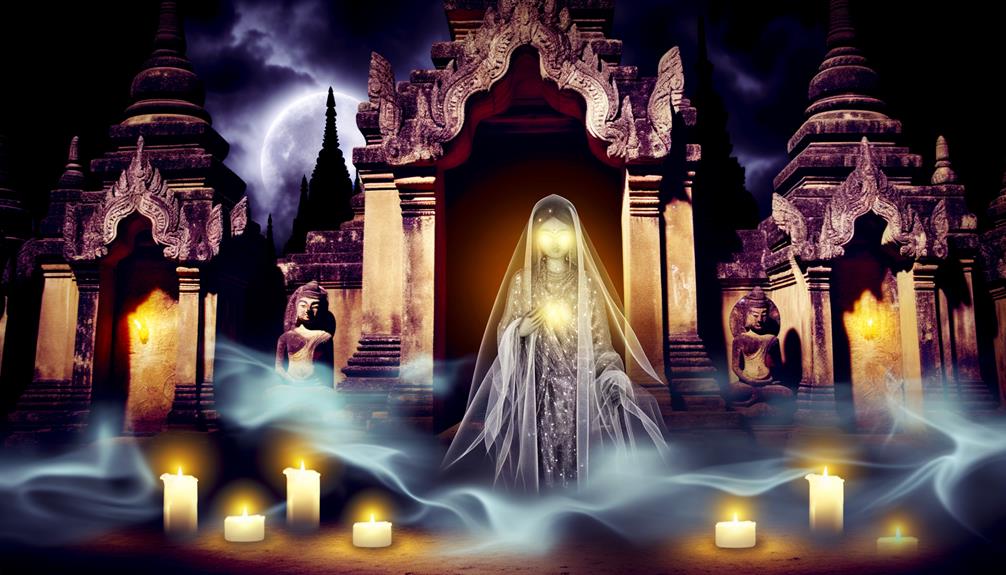
The concept of a ‘veil over the eyes‘ has its historical origins deeply rooted in ancient religious texts and cultural traditions, often symbolizing spiritual ignorance or a barrier to divine understanding.
This metaphorical veil is particularly referenced in the Judeo-Christian tradition, wherein the Apostle Paul speaks of a ‘veil’ that prevents the Israelites from fully understanding the covenant of Moses (2 Corinthians 3:14-16).
Similarly, in Hindu scriptures, the term ‘Maya’ refers to the illusion that obscures true spiritual knowledge.
Ancient Egyptian mythology also depicts veils as barriers to the afterlife, only to be lifted through ritual and moral purity.
These historical references collectively underscore a universal motif: the veil as a symbol of the soul’s journey towards enlightenment and ultimate truth.
Symbolism in Religion
In religious symbolism, the veil frequently represents a boundary between the mundane and the divine, encapsulating the human struggle to transcend earthly limitations and achieve spiritual clarity. This metaphorical barrier finds resonance across various religious traditions, each attributing unique meanings to the veil.
| Religion | Symbolic Meaning of the Veil |
|---|---|
| Christianity | Separation of humanity from God |
| Islam | Modesty and spiritual purity |
| Judaism | Sacredness and divine protection |
| Hinduism | Maya, the illusion separating humans from truth |
| Buddhism | Ignorance and the path to Enlightenment |
The veil therefore serves as a potent symbol, reflecting the inherent tension between the seen and unseen, the known and unknown, urging believers to seek higher understanding and spiritual liberation.
Mystical Interpretations
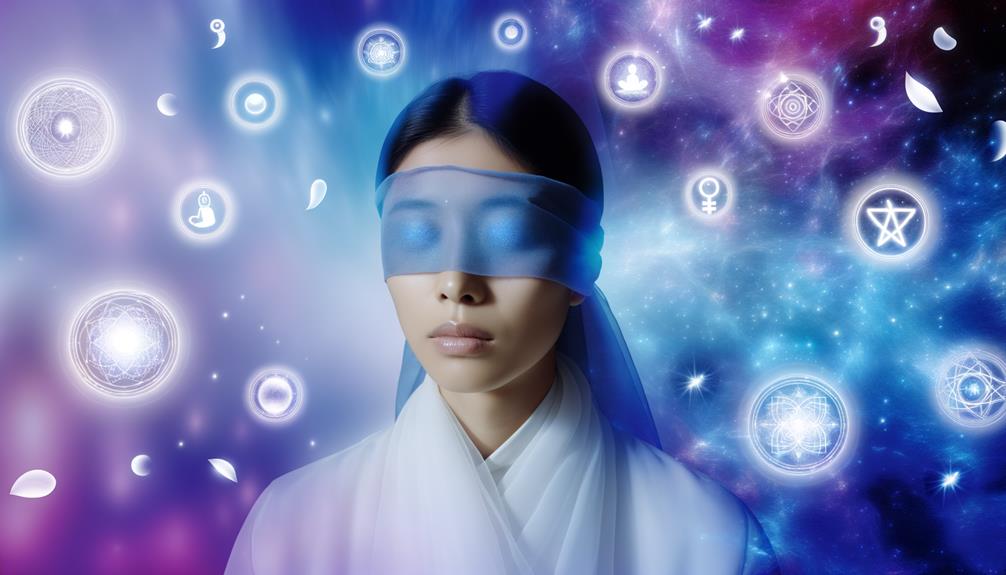
Mystical interpretations of the ‘veil over eyes‘ often allude to symbolic hidden truths, suggesting an esoteric layer of knowledge accessible only to the initiated.
This concept is deeply rooted in the notion of sacred spiritual blindness, where limitations of physical sight are seen as openings to higher spiritual insights.
Scriptural references across various religious traditions emphasize the transformative power of this blindness, positioning it as a conduit for divine revelation.
Symbolic Hidden Truths
When examining the spiritual symbolism of a veil over the eyes, one uncovers a profound metaphor for the concealment of deeper truths and hidden knowledge. This mystical interpretation suggests that the veil serves as a barrier, shielding individuals from the full revelation of divine mysteries.
Scripturally, such a veil may represent the limitations of human perception, emphasizing the need for spiritual awakening and divine intervention to lift it.
Key symbolic hidden truths include:
- Divine Protection: The veil safeguards sacred knowledge from the uninitiated.
- Inner Transformation: It signifies a journey towards enlightenment, requiring inner purification.
- Mystery of Faith: The veil underscores the enigmatic nature of divine wisdom, which unfolds progressively.
This layered symbolism invites continuous contemplation and spiritual growth.
Sacred Spiritual Blindness
The concept of sacred spiritual blindness emerges as a profound extension of the veil metaphor, illustrating how the intentional obscuration of divine truths serves as a mechanism for spiritual refinement and maturation.
Scriptural texts often allude to this sacred blindness as a divine strategy to foster deeper faith and reliance on the unseen. For instance, in Isaiah 6:10, the prophet speaks of hearts being hardened and eyes being closed.
This purposeful concealment compels seekers to transcend superficial understanding, urging an introspective journey towards enlightenment.
Consequently, sacred spiritual blindness is not merely an absence of sight but an invitation to perceive with the heart and spirit, encouraging a transformative process that aligns the soul closer to divine wisdom and ultimate truth.
Psychological Perspectives
From a psychological perspective, the metaphor of a ‘veil over the eyes’ often symbolizes cognitive dissonance or a lack of awareness hindering one’s perception of reality.
This phenomenon can manifest in various ways, obstructing an individual’s capacity to fully comprehend their surroundings or internal states.
Psychologists identify several key aspects:
- Cognitive Dissonance: The mental discomfort experienced when holding two conflicting beliefs, leading to perceptual veils that obscure truth.
- Selective Attention: A process where individuals focus on specific stimuli while ignoring others, effectively ‘veiling’ certain aspects of reality.
- Denial Mechanism: A defense mechanism where uncomfortable realities are ignored or dismissed, creating a metaphorical veil.
These psychological barriers can profoundly impact one’s ability to engage with and understand the world authentically.
Cultural Variations
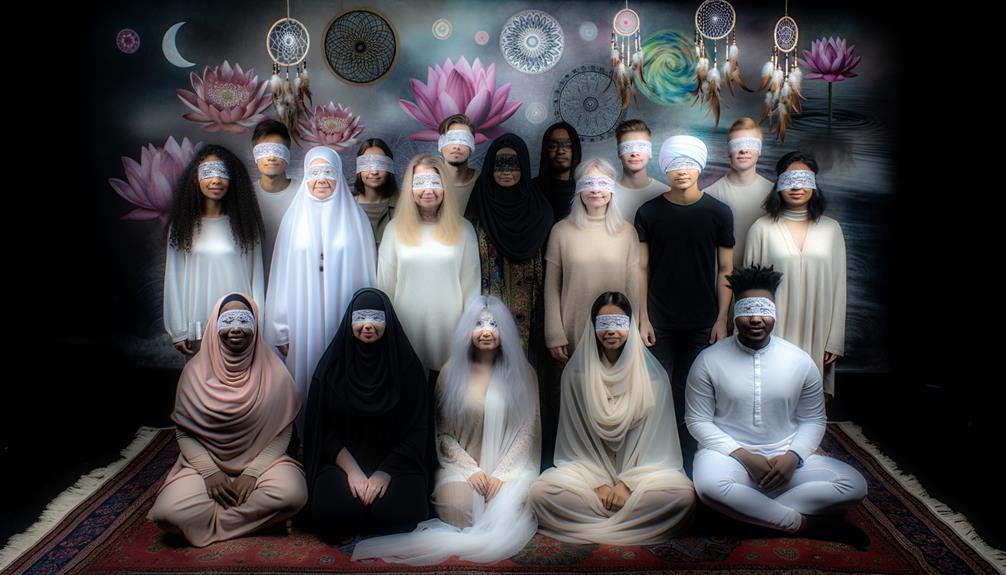
Cultural interpretations of the veil over the eyes vary considerably, reflecting a rich tapestry of symbolism and religious beliefs.
For instance, in some Eastern traditions, the veil signifies spiritual insight, whereas in certain Western contexts, it may represent mystery or concealment.
Examining these diverse perspectives provides a broader understanding of how this motif is woven into the fabric of human spirituality across different societies.
Symbolism in Different Cultures
Significantly, the symbolism of a veil over the eyes manifests distinctively across various cultures, often embodying themes of mystery, spirituality, and transformation.
In ancient Egyptian culture, the veil signified a barrier between the mortal and divine domains, representing an initiation into higher knowledge.
In Japanese Noh theatre, masks serve as veils, concealing and revealing the inner psyche and emotions of characters, thereby illustrating transformation.
Additionally, in Greek mythology, the veil of the goddess Isis symbolizes the mysteries of life and death, encouraging seekers to disclose deeper spiritual truths.
- Ancient Egypt: Veil as a barrier to divine knowledge.
- Japanese Noh Theatre: Masks as veils for inner transformation.
- Greek Mythology: Veil of Isis representing life’s mysteries.
Religious Interpretations Worldwide
Across various religious traditions, the concept of a veil over the eyes often symbolizes the separation between the mundane and the sacred.
In Christianity, the veil represents the barrier between humanity and divine understanding, as seen in 2 Corinthians 3:15-16.
In Hinduism, the term ‘Maya’ signifies an illusory veil that obscures the ultimate reality, as articulated in Vedantic scriptures.
Similarly, in Islam, the veiling of women (Hijab) extends metaphorically to the veiling of divine truth, invoking a sense of spiritual modesty and reverence.
In Buddhism, the notion of ‘avidya’ or ignorance acts as a veil that clouds one’s perception of enlightenment.
These religious interpretations underscore a universal quest to transcend the visible and attain a profound spiritual awakening.
Modern Spirituality
In modern spirituality, the concept of a veil over the eyes often symbolizes a barrier to deeper spiritual awareness and enlightenment. This metaphorical veil can be attributed to various factors, which impede one’s journey towards divine understanding and self-realization.
Key elements include:
- Material Distractions: The preoccupation with material wealth and sensory pleasures often diverts focus from spiritual pursuits.
- Ego and Pride: A strong identification with the ego creates illusions of separation from the divine, obstructing genuine spiritual connection.
- Cultural Conditioning: Societal norms and cultural indoctrination can limit one’s perspective, hindering the ability to perceive spiritual truths.
Recognizing these barriers is essential for those seeking to transcend superficial existence and attain a more profound spiritual experience.
Practices to Lift the Veil
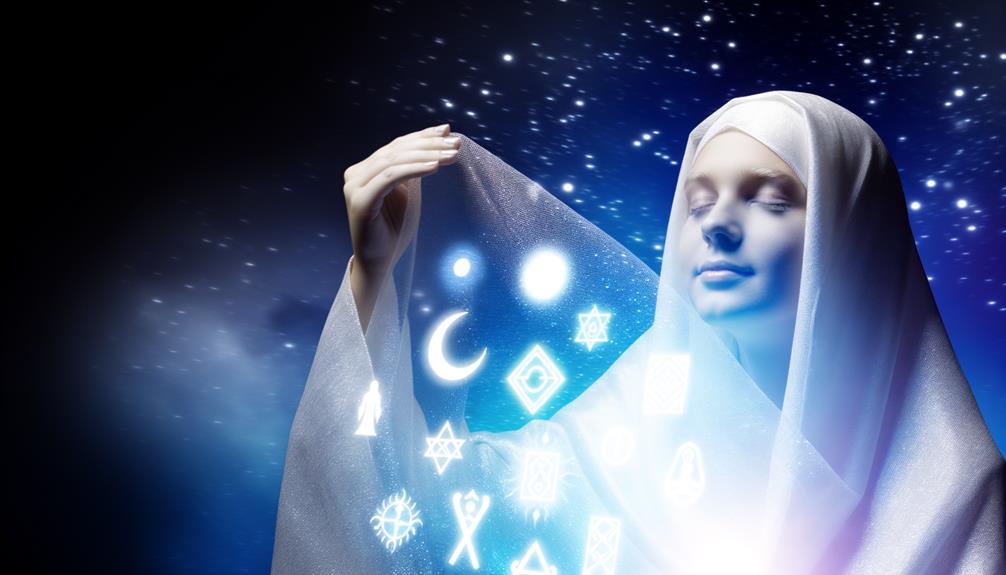
To overcome the obstacles presented by material distractions, ego, and cultural conditioning, individuals can engage in specific spiritual practices designed to lift the metaphorical veil and enhance their connection with the divine.
Meditation, an ancient practice rooted in various religious traditions, serves as a powerful tool for quieting the mind and cultivating inner awareness.
Similarly, prayer, when approached with sincerity and devotion, opens channels to the transcendent.
Scriptural study offers profound insights, guiding seekers toward deeper understanding and enlightenment.
Engaging in acts of selfless service (seva) also helps to dissolve ego and foster spiritual growth.
Together, these practices create a harmonious path, enabling individuals to transcend superficial barriers and perceive the divine presence within and around them.
Personal Experiences
Many individuals recount transformative personal experiences wherein the lifting of the metaphorical curtain has led to profound spiritual awakenings and a heightened sense of divine presence. These narratives often highlight pivotal moments that engender deeper spiritual understanding.
Such experiences can be categorized as follows:
- Sudden Epiphanies: Individuals describe moments of sudden clarity where previously obscure spiritual truths become vividly apparent.
- Prolonged Meditation: Through sustained meditative practices, practitioners report a gradual revealing of deeper metaphysical insights.
- Life-Altering Events: Significant life events, such as near-death experiences or personal crises, often act as catalysts for the removal of spiritual veils, leading to enhanced divine perception.
These testimonies underscore the varied yet profound ways in which the spiritual veil can be lifted.
Conclusion
The spiritual motif of a veil over the eyes, traversing historical, religious, and psychological domains, serves as a potent symbol of obscured perception and enlightenment.
From ancient texts to modern spiritual practices, this concept encapsulates humanity’s quest for deeper understanding. The varied interpretations underscore its universal resonance.
Consequently, the veil signifies both the barriers to and the pursuit of transcendent knowledge, a timeless endeavor as relevant today as in the days of yore.






